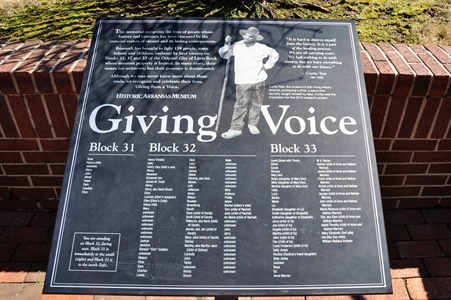By Victoria Chandler, Arkansas Made Researcher, and Joleen Linson, Director of Education
Over Historic Arkansas Museum’s 79 year lifespan, our interpretation of the people who lived on these historic blocks has certainly changed. When Louise Loughborough opened the museum in 1941, she only shared the lives of the white settlers on these blocks. Over the years, Historic Arkansas Museum has made it part of its mission to tell the story of every person who lived and worked on Blocks 31-33.
Part of the difficulty as a museum is that we share stories through objects. But there are very few objects that we know were made and used by enslaved people. Despite the lack of material culture the institution of slavery naturally left behind, Historic Arkansas Museum decided that in order to tell these stories theater was the best option. Curtis Tate, a brilliant local actor, was the first full-time interpreter at the museum. His dream was to have every enslaved person known to have lived and worked on the museum’s grounds represented in a monument and in performances. Hence the creation of the Giving Voice memorial.
However this was easier said than done. Prior to this (in the mid-2000s), little effort had been taken to track down all of the enslaved individuals from the blocks. Keep in mind that this spans a forty year period and different generations of people and families. With the help of a college student, the museum began an in-depth, systematic research project to try and identify all of these individuals.
We combed through the Pulaski County tax records, property tax records, deed books, the slave schedules, newspapers, and any other archival references. We were able to figure out a close estimate as to the number of enslaved individuals who lived and worked here, and, luckily, even found some of their names. Most enslaved individuals are simply listed as an enumerated mark and are given no names. The mission of the Giving Voice memorial is to recognize the lives of people whose history and existence has been obscured by the immoral system of slavery and its lasting consequences. The museum continues to tell the stories and lives of these 139 enslaved men, women, and children who lived on these blocks from the 1820s to 1860s before freedom.
In 2010 we dedicated the Giving Voice memorial, which is an essential stop on every tour given on the grounds. Although we may never know more about these souls, we recognize and celebrate their lives, Giving them a Voice. The following is just a few of the stories we know about these people.
Tabby- For a long time Tabby was the only person we knew by name who was enslaved on the museum’s property because she was mentioned in the memoir of Robert Brownlee, the brother of Tabby’s owner James Brownlee. Robert built James and his wife a brick house on the block next to the Hinderliter Grog Shop. Once the family arrived to Little Rock from Scotland, James purchased two individuals - Tabby and a man. Unfortunately his name has been lost to history. We know Tabby and a little bit about her life because Robert wrote that Tabby had to suffer the “unbridled passion” of his sister-in-law who was given to the sulks.
Silas, Sally, and Paulina Jones- Silas was a free man, but his wife Sally was not. She was enslaved by Chester Ashley who lived where our farmstead is currently located. Silas and Sally had a daughter named Paulina. She was also enslaved because her mother was enslaved. Silas worked and earned the money to purchase his wife from the Ashleys, and then freed Sally. Silas and Sally eventually earned enough to purchase their daughter from the Ashleys.
James, Diana, Elecicia (Sara)- James, Diana, and Elecicia were purchased by Thomas Thorn from William Cook for $500. Elecicia was just 10 weeks old making her the youngest person we found listed as enslaved on the museum property.
Joshua and Jackson- Joshua and Jackson were two young boys, ages 12 and 14, who were purchased by John Barkeloo for the sole purpose of taking care of his 2 year old daughter, Mary Ellen. They were to be her caretakers until she turned 21 or was married if she did not marry until after she was 21. After she was married or 21, Joshua and Jackson were to be given to Mary Jane, John’s wife.
Anne Warren- Anne Warren was the daughter of the cook for the Ashley family. She was married to Nathan Warren, who was freed and worked as the carriage driver for the Ashleys. Anne and Nathan had 9 children, all of whom were enslaved by the Ashley family. Anne died around 1853 and is buried in the Ashley family plot at Mount Holly Cemetery.
